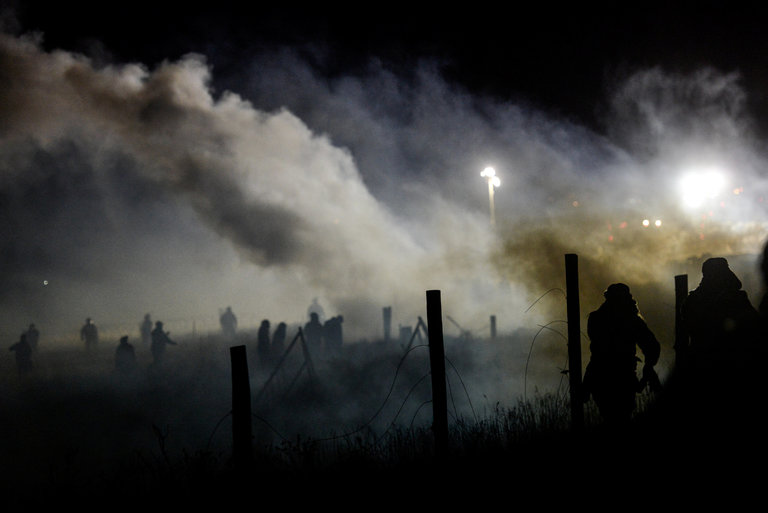Power Imbalance at the Pipeline Protest
ACTIVISM, 28 Nov 2016
The New York Times | Editorial – TRANSCEND Media Service

Police used tear gas on demonstrators opposed to the Dakota Access oil pipeline in North Dakota, on Sunday.
Credit Stephanie Keith/Reuters
23 Nov 2016 – When injustice aligns with cruelty, and heavy weaponry is involved, the results can be shameful and bloody. Witness what happened on Sunday [20 Nov] in North Dakota, when law enforcement officers escalated their tactics against unarmed American Indians and allies who have waged months of protests against the Dakota Access oil pipeline.
They drenched protesters with water cannons on a frigid night, with temperatures in the 20s. According to protesters and news accounts, the officers also fired rubber bullets, pepper spray, percussion grenades and tear gas. More than 160 people were reportedly injured, with one protester’s arm damaged so badly she might lose it.
The confrontation happened at Backwater Bridge, on a highway linking the Standing Rock Sioux Reservation and Bismarck, N.D. Burned-out trucks and a police barricade have made the bridge impassable. Protesters say this is a needless threat to public safety — forcing emergency vehicles to detour about 20 miles — as well as a spiteful attempt to keep them away from the pipeline construction site. The violence erupted after some of the protesters tried to remove the truck carcasses on Sunday.
“We’re just not going to let people or protesters in large groups come in and threaten officers, that’s not happening,” said the Morton County sheriff, Kyle Kirchmeier. The Sheriff’s Department’s Facebook page linked to a video of the armed and armored officers, the water cannon drenching the crowd, and a rock flying overhead.
The pipeline, all but built, is meant to ship crude oil from North Dakota to Illinois. Built almost entirely on private property, the pipeline crosses ancestral lands of the Standing Rock Sioux, passing less than a mile from the tribal reservation. Tribe members fear contamination of their drinking water and damage to sacred sites. They are trying to persuade the federal government to deny permits allowing the pipeline to cross the Missouri River near their reservation.
The department’s video was meant to portray the protesters as dangerous troublemakers, but the photos and videos in news reports suggest a more familiar story — an imbalance of power, where law enforcement fiercely defends property rights against protesters’ claims of environmental protection and the rights of indigenous people. American Indians have seen this sort of drama unfold for centuries — native demands meeting brute force against a backdrop of folly — in this case, the pursuit of fossil fuels at a time of sagging oil demand and global climatic peril.
The Army Corps of Engineers has called for more study and input from the tribe before it decides on whether to grant a permit. The pipeline company has asked a federal judge to give it the right to proceed with its plan to lay pipe under the river. There is no firm timeline for either decision.
In the meantime, President Obama could step in to protect everyone’s safety and pressure the sheriff’s officers to stand down. Barring that, resolute protesters, a heavily militarized police force unwilling to budge, a company that refuses to consider an alternate route and an onrushing Great Plains winter — how can this possibly end well?
____________________________________
A version of this editorial appears in print on November 23, 2016, on page A26 of the New York edition with the headline: Power Imbalance at the Pipeline Protest.
DISCLAIMER: The statements, views and opinions expressed in pieces republished here are solely those of the authors and do not necessarily represent those of TMS. In accordance with title 17 U.S.C. section 107, this material is distributed without profit to those who have expressed a prior interest in receiving the included information for research and educational purposes. TMS has no affiliation whatsoever with the originator of this article nor is TMS endorsed or sponsored by the originator. “GO TO ORIGINAL” links are provided as a convenience to our readers and allow for verification of authenticity. However, as originating pages are often updated by their originating host sites, the versions posted may not match the versions our readers view when clicking the “GO TO ORIGINAL” links. This site contains copyrighted material the use of which has not always been specifically authorized by the copyright owner. We are making such material available in our efforts to advance understanding of environmental, political, human rights, economic, democracy, scientific, and social justice issues, etc. We believe this constitutes a ‘fair use’ of any such copyrighted material as provided for in section 107 of the US Copyright Law. In accordance with Title 17 U.S.C. Section 107, the material on this site is distributed without profit to those who have expressed a prior interest in receiving the included information for research and educational purposes. For more information go to: http://www.law.cornell.edu/uscode/17/107.shtml. If you wish to use copyrighted material from this site for purposes of your own that go beyond ‘fair use’, you must obtain permission from the copyright owner.